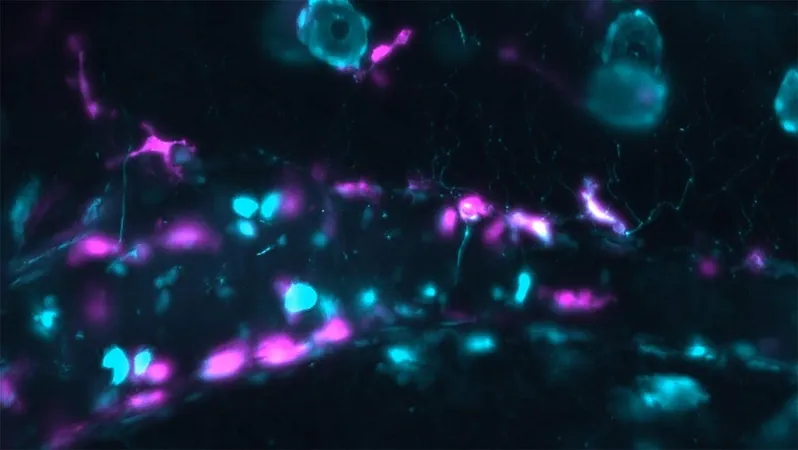
Unraveling Gut Pain: How Bad Bacteria Trigger Digestive Chaos
2024-12-18
Author: Rajesh
Introduction
After indulging in questionable seafood or sipping contaminated water, your digestive tract can dramatically respond. Bad bacteria can cause the intestines to spasm and contract, leading to a rush to expel all contents—a phenomenon many can relate to after a bout of food poisoning.
Research Insights
Recent groundbreaking research from the University of Oregon sheds light on the specific mechanisms by which the notorious bacterium Vibrio cholerae incites these unpleasant gut contractions. This study provides crucial insights into how our gut defends itself from unwanted intruders and may pave the way for better understanding of chronic digestive issues such as inflammatory bowel disease (IBD).
Expert Commentary
According to Karen Guillemin, a microbiologist involved in the research, 'This isn’t just a specific dirty trick of Vibrio bacteria; rather, the gut is designed to flush out harmful substances when damage occurs.'
Study Publication Details
The study, led by now-graduated doctoral student Julia Ngo, was published in the journal *mBio* on November 22. Vibrio cholerae is infamous for its role in causing cholera, an ailment that endangers millions annually, primarily through contaminated water sources. A closely related Vibrio species is also a common culprit in food poisoning linked to shellfish.
Previous Research
Earlier studies conducted by Parthasarathy's team indicated that Vibrio cholerae significantly intensifies gut contractions in zebrafish, whose transparency in larval stages makes them ideal for real-time investigation of microbial dynamics in the digestive system.
Mechanism of Action
The latest research identifies a sword-like appendage, generally utilized by Vibrio as a weapon against other microbes, as the catalyst for the heightened gut activity. However, the precise mechanism remained elusive until this study revealed the role of immune cells known as macrophages.
Role of Macrophages
In typical scenarios, macrophages regulate neuronal activity in the gut to ensure calm peristalsis—smooth muscle contractions that move food along the digestive tract. Yet, when bacteria inflict tissue damage, macrophages abandon their posts to deal with the injury, leaving neuronal activity unchecked. This lack of regulation subsequently leads to intense contractions.
Researcher's Observation
Parthasarathy expressed amazement at the coordination of cellular activity: 'The dynamics of macrophages racing across the fish, with neurons and muscles pulsating with energy, showcase an intricate biological ballet. Observing these processes in live animals is paramount to our understanding.'
Protective Response
Though these vigorous gut contractions can be a protective response for both zebrafish and humans, they serve an additional purpose: pushing harmful substances out of the body. As Guillemin explains, 'If macrophages are deployed to manage an injury, it makes perfect sense for neurons to trigger a rapid expulsion of anything harmful in the gut.'
Bacteria and Host Interaction
Intriguingly, this rapid gut expulsion could benefit the bacteria by granting them quick access to new hosts. However, Guillemin warns against attributing too much strategy to microbes, suggesting that the interaction between Vibrio’s weaponry and the host’s response is likely a fortuitous coincidence rather than a sophisticated evolutionary tactic.
Health Implications
The study also underscores the significant interplay between the immune and nervous systems in maintaining gut health, a relationship that warrants deeper exploration to provide insights into a plethora of enigmatic diseases.
Future Directions
With the backing of the National Science Foundation and the National Institutes of Health, this research could reshape how we approach gut health moving forward, offering a glimmer of hope for those suffering from chronic digestive ailments.
Conclusion
As science continues to unravel the complexities of gut-brain interactions, the quest for understanding and possibly combating chronic conditions like IBD may soon have new allies. Stay tuned as this dynamic field progresses!




 Brasil (PT)
Brasil (PT)
 Canada (EN)
Canada (EN)
 Chile (ES)
Chile (ES)
 España (ES)
España (ES)
 France (FR)
France (FR)
 Hong Kong (EN)
Hong Kong (EN)
 Italia (IT)
Italia (IT)
 日本 (JA)
日本 (JA)
 Magyarország (HU)
Magyarország (HU)
 Norge (NO)
Norge (NO)
 Polska (PL)
Polska (PL)
 Schweiz (DE)
Schweiz (DE)
 Singapore (EN)
Singapore (EN)
 Sverige (SV)
Sverige (SV)
 Suomi (FI)
Suomi (FI)
 Türkiye (TR)
Türkiye (TR)